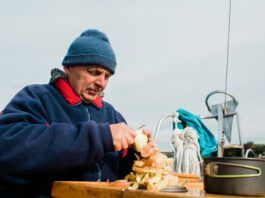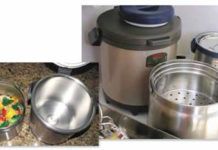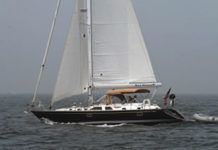Filters for Water Tank Vents
Ever find a bug doing the backstroke in your water tank? We have. Would you leave a glass of water sitting uncovered for weeks and then come back to it? Of course not, but many builders either lead the hose to a mushroom-type through-hull fitting, or terminate it inside the cabin, with nothing to keep the ubiquitous critters from seeking shelter, fresh water, or a nesting site.
Taking the Other Way Home
Our 38-foot catamaran, Josepheline, was built by Lightwave Yachts near Brisbane, Australia. Josepheline draws 3 feet, 6 inches and has a 22-foot beam. It is a fairly conventional design: mini fin keels, two forward queen berths under the bridgedeck, a double berth aft to starboard, and a decent sized shower and head located aft in the port hull. Shes stood the test of time-and distance. Weve cruised about 35,000 nautical miles aboard Josepheline.
Brewing Coffee in the Galley
We compared four popular, portable coffee-making methods in search of the best java-brewing method for the galley. The test evaluated French presses, percolators, drip-cone coffeemakers, and various instant coffees. Testers tried out a handful of products using each method, including the BonJour, Nissan Thermos, and Bodum French presses, as well as the Aerobie AeroPress, the Melitta Perfect Brew, the Clever Dripper, Bialetti Moka Express, and the Farberware Yosemite and Medelco stovetop percolators.
Fine-tuning Fridge Efficiency
Do aftermarket smart controls really improve your fridge compressors efficiency? In this update to our marine refrigeration tests (PS, April and June 2009), we review Isotherms new automatic Smart Energy Controller (SEC) and take a look at trends in marine refrigeration.
The Galley: Where Form Meets Function
Cooking a great meal in a cavernous kitchen outfitted with every imaginable culinary device can be difficult enough, but doing it in the confined space of a sailboat presents greater challenges, some the result of ill-conceived galley layouts. But what makes up a dream galley for cooking underway? To find out, Practical Sailor interviewed full-time chefs working aboard sailboats, as well as cruising sailors who have experienced first-hand the challenges of putting together a meal in a pounding sea. The report looks at the ideal location and for the galley, counterspace and ventilation needs, sink and stove must-haves, storage tips, and safety concerns.
Thermos Thermal Cooker Review
Practical Sailor contributor Jonathan Neeves-a bluewater cruiser living aboard his Lightwave 38 catamaran in Australia-has used thermal cookers for 30 years and says that he would never sail without one. In this article, Neeves reviews the Thermos-brand thermal cookers that he uses on board for cooking stews, casseroles, soups, desserts, and other dishes. The thermal cooker is a large, stainless vacuum flask containing one or two fitted saucepans. The insulation traps the heat in the food and uses it as the heat source for cooking the dishes. Using thermal cooker saves cooking-fuel (or power) and allows sailors to safely cook a meal while underway-without constant stovetending or worry over spilled pots-even in foul weather, when slaving over a galley stove can prove challenging and dangerous.
What’s Cooking Now?
The galley may be the last place you’d expect to see new technologies, but our tour last year aboard the custom Fastwater 52 cat Ice Wars (Inside Practical Sailor, June 2011) introduced us to a new way of onboard cooking. Rather than a standard oven, Ice Wars was outfitted with only an infrared oven that was small enough to stow in a galley cupboard. Intrigued—and a little skeptical—we decided to have a go at using one of these new-age cookers to see whether it was a functional and practical galley tool.
Whats Cooking Now?
The galley may be the last place you’d expect to see new technologies, but our tour last year aboard the custom Fastwater 52 cat Ice Wars (Inside Practical Sailor, June 2011) introduced us to a new way of onboard cooking. Rather than a standard oven, Ice Wars was outfitted with only an infrared oven that was small enough to stow in a galley cupboard. Intrigued—and a little skeptical—we decided to have a go at using one of these new-age cookers to see whether it was a functional and practical galley tool.
Reviving the Galley Spark
Any thoughts on how to get the “spark” back in the burners on our Force 10 stove? The ignition sparkers on all three burners are, at best, sporadic. I’ve gotten some basic info from the factory, but it hasn’t helped. The ignitor’s battery has been replaced, the ends cleaned, and what I thought might be the issue—stove grease—has been taken care of.
No Supermarket At Sea
Cooking at sea has never been easy and is usually looked upon as a dull, but necessary task. Nothing can spur the queasy stomach to open rebellion more effectively than going below to a hot, stuffy galley to prepare , ugh! - food. Why would anyone in his right mind try to prepare a meal at a 30' heel while the rest of the crew enjoy a sail on deck? The term, 'slaving over a hot stove', takes on new meaning. Yet, the cook is a vitally important member of the ship's crew, and it is not an easy job. Whether on a delivery, racing or long distance cruising, a non-stop passage on your boat means no nipping out to buy that missing ingredient: there are no supermarkets at sea! So remember, the moment you leave the dock you'd better be sure you haven't forgotten anything. If you like acronyms, here are two secrets to success that you can remember: The Six P's, and MAMAS Theory.

















































